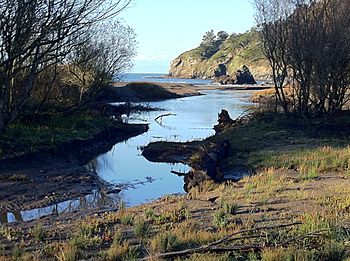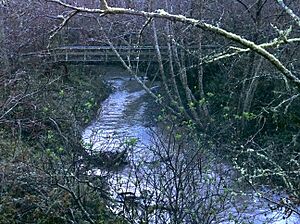Redwood Creek (Marin County) facts for kids
Quick facts for kids Redwood Creek |
|
|---|---|

Redwood Creek flowing west to its mouth at Muir Beach
|
|
| Country | United States |
| State | California |
| Region | Marin County |
| Physical characteristics | |
| Main source | Mount Tamalpais confluence of Bootjack, Rattlesnake and Spike Buck Creeks 37°54′14″N 122°35′22″W / 37.90389°N 122.58944°W |
| River mouth | Pacific Ocean Muir Beach, California 0 ft (0 m) 37°51′35″N 122°34′40″W / 37.85972°N 122.57778°W |
| Length | 4.7 mi (7.6 km) |
| Basin features | |
| Basin size | 7 sq mi (18 km2) |
| Tributaries |
|
Redwood Creek is a small but important stream in Marin County, California. It is about 4.7 miles (7.6 km) (7.6 km) long. This creek drains a 7-square-mile (18 km2) (18 square km) area of land called a watershed. This watershed includes the famous Muir Woods National Monument. Redwood Creek flows into the Pacific Ocean near Muir Beach, just north of the Golden Gate.
Contents
History of Redwood Creek and Muir Beach

Long ago, the Coast Miwok people lived in the Redwood Creek area. The Huimen tribe was one of their local groups. An old Native American site called CA-MRN-33 near Big Lagoon is now a protected historical place.
In the past, families like the Banduccis farmed the land near the creek. They built walls called levees in 1948-1949 to stop the creek from overflowing. These levees made the creek flow in a very straight line, which was not natural. People even called this part the "Bowling Alley" because it was so straight.
Later, in 1945, George Wheelwright, who helped start Polaroid, bought land in the area. He created pastures by digging drainage channels and building a dam. In 1967, he gave the Muir Beach area to California State Parks. They built a large parking lot where it is today. In 1972, Wheelwright sold the Green Gulch Farm. It became the Green Gulch Farm Zen Center.
Amazing Animals and Their Homes
Redwood Creek is a very special place for several types of fish. It is a vital spot for coho (also called silver salmon), coastal cutthroat, and steelhead trout. These fish are all threatened species, meaning their numbers are very low.
Coho Salmon: A Special Fish
The coho salmon in Redwood Creek are unique. They have never been brought in from other places, so their DNA is special. These salmon are part of the Central Coast coho salmon group, which has been listed as a federally threatened species since 2006. They were even listed as federally endangered species in 2005.
Coho salmon live in the ocean for about two years. Then, they swim back to freshwater creeks like Redwood Creek to lay their eggs. This is their only chance to reproduce. They usually start their journey upstream in December or January, after heavy winter rains break open the sandbar at Muir Beach.
Challenges for Salmon Survival
For a few years, very few or no salmon were seen returning to Redwood Creek. Scientists thought this was because young salmon did not have enough places to rest and hide in the creek. There was a lack of large fallen trees and deep pools.
Helping the Salmon Return
To help the salmon, the National Park Service started restoring Muir Beach in 2009. Their goal was to make the ecosystem healthy again and improve access for visitors. This work was very important because coho salmon only live for about three years.
Luckily, in January 2010, about 45 coho salmon swam up Redwood Creek to lay eggs. This was the first time in three years! They created 23 "redds," which are nests of eggs. In 2011, more salmon were seen, showing a small increase.
Sadly, the number of coho salmon across California is only 1% of what it was in the 1940s. They have disappeared from 90% of the streams they used to visit. In 2014, no salmon returned to Redwood Creek, which made people worry they might be gone from the area forever. However, some male coho salmon were moved from Redwood Creek and released with female salmon from another creek. This project, called "coho jumpstart," gives hope for the salmon's return.
Restoring the Creek's Habitat
In 2003, the National Park Service finished the first part of a restoration project. They built artificial log jams using eucalyptus trees and broke down the old levees. This helped the creek flow more naturally and created pools where young salmon could grow. They also removed plants that didn't belong there and planted native ones. This helps birds find places to nest.
Since 2009, a bigger project has been underway to restore the creek's floodplain. This involves creating a new, winding channel for the creek with smaller side-channels. The goal is to bring back the historic "Big Lagoon" that used to be there.
Other Rare Animals in the Watershed
Redwood Creek is also home to other rare animals:
- The northern spotted owl (Strix occidentalis caurina)
- The California red-legged frog (Rana aurora draytonii)
In 2009, a pond was dug at Green Gulch Farm to create a home for the California red-legged frog. This is the only group of these frogs in the whole watershed.
River otters (Lontra canadensis) have also been seen in Redwood Creek since 1996. They come back every year to eat steelhead trout.
Understanding the Redwood Creek Watershed
The Redwood Creek watershed is the entire area of land where all the rain and water eventually flow into Redwood Creek. The creek itself starts when Bootjack Creek, Rattlesnake Creek, and Spike Buck Creeks join together on Mount Tamalpais. Even though the main creek starts lower down, its smaller streams begin high up on the mountain.
Other streams that flow into Redwood Creek include Fern Creek, Kent Creek, and Green Gulch Creek. In the past, before people changed the land, there was a large lagoon at the mouth of Redwood Creek. This lagoon used to cover about 25 acres (100,000 m2) (10 hectares). Today, only a small part of that lagoon remains.
Bridges Over Redwood Creek
Several bridges cross Redwood Creek:
- A concrete bridge on Muir Woods Road, about 0.7 miles (1.1 km) north of State Route 1. It was built in 1958.
- A concrete culvert at milepost 6.02 on State Route 1. It was built in 1926 and rebuilt in 1970.
- A concrete bridge on Pacific Way, about 0.09 miles (140 m) south of State Route 1. It was built in 1956.
- Another concrete bridge on Muir Woods Road, about 2.0 miles (3.2 km) north of State Route 1. It was built in 1946.
Images for kids
-
Redwood Creek about one mile below Muir Woods National Monument


